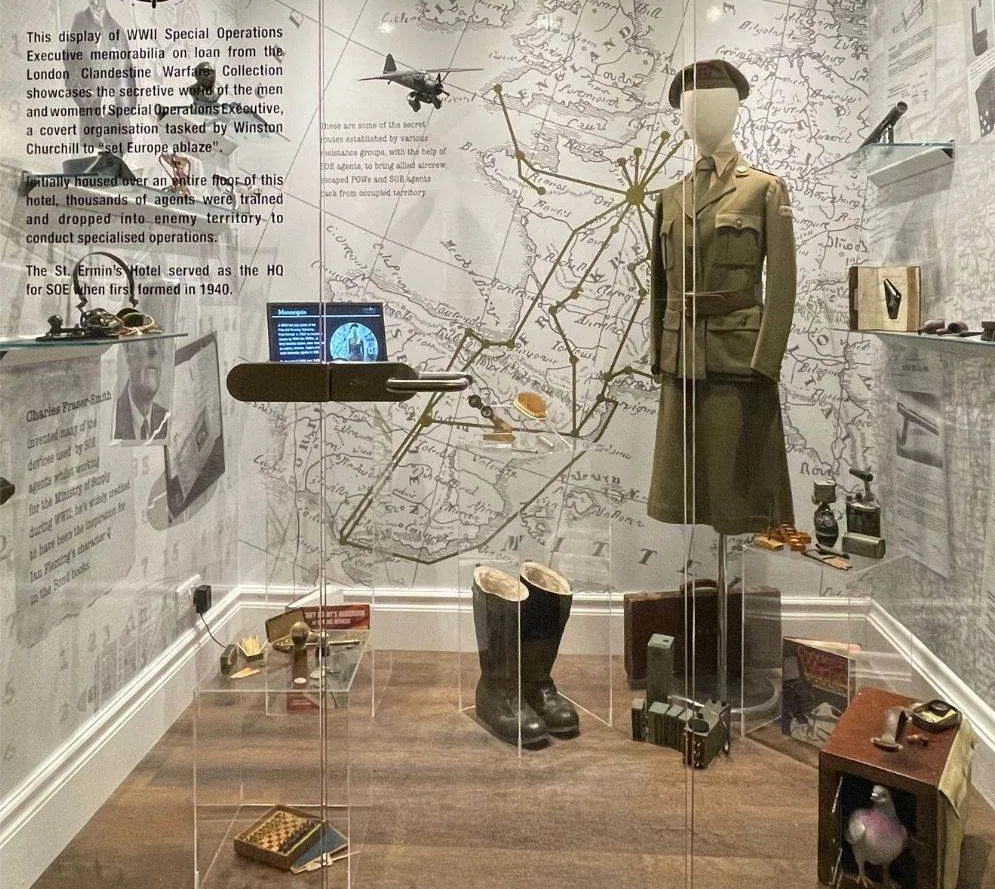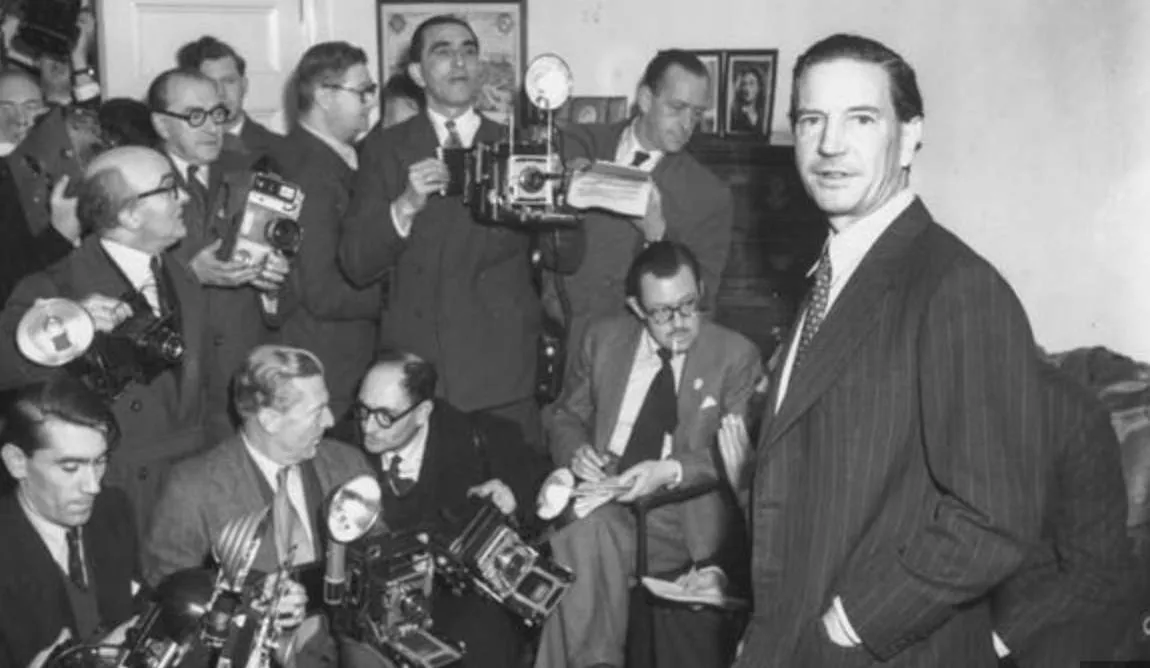St. Ermin's Hotel: The Secret Lair of British & Russian Spies
At the start of WWII, St, Ermin’s Hotel was a venue for guerilla war classes run partly by MI6. Spies and celebrities mingled including 007 creator Ian Fleming. Playwright Noel Coward worked with Britain’s Secret Intelligence Service and sought to persuade his American fans and US politicians to help Britain in the war effort.
London’s St. Ermin's Hotel was dubbed the ‘Works Canteen’ by Britain’s top spies, thought of as a second office where the Admiralty, MI6, and MI5 officers could unwind in the Caxton Bar - or, in some cases, secretly meet their Russian handlers.
Cambridge Five traitors Guy Burgess and Kim Philby are said to have brazenly socialized with their Moscow contacts in plain view of co-workers and hotel guests. They “didn't talk out the side of their mouths and have red carnations and copies of the Financial Times under their arm,” Stephen Duffy, security manager at the grand hotel, has said. “They just all passed over their paperwork in plain sight.”
Since opening its doors in 1899, St. Ermin’s Hotel has been inextricably linked to espionage. Even today the hotel remains at the heart of Britain’s power nexus, a comfortable stroll from Buckingham Palace, the Prime Minister’s home at 10 Downing Street, the Houses of Parliament, and MI6 and MI5 HQs further down the Thames River.
.webp)
St. Ermin’s Hotel, where the walls have ears
During WWI, the hotel was used as a hospital for injured soldiers returning from France and Belgium. A small British intelligence detachment was in situ to gather any morsels of intel from the troops. The bulk of the intelligence services were located in the same neighborhood, holed up nearby in the Admiralty Buildings.
Room 40 O.B. (Old Building) housed the British cryptanalysis section that decrypted about 15,000 German wireless and telegraph communications during the first great war. After a stressful day, they’d drop by the ‘Works Canteen’ for a respite from the stress and a refreshing beverage.
British Prime Minister Winston Churchill, himself a WWI veteran, had at one point overseen Room 40 and fully supported the intelligence services and their black arts. Under Churchill’s leadership during the Second World War, Britain’s spies outgrew their office space and moved the overflow into rooms at the spy hotel. The Special Operations Executive (SOE), also known as Churchill’s Secret Army, took over an entire floor. Section D - the demolition experts - lived on the top floor of the hotel where they reportedly stashed explosives.
“The Intelligence directorate and offices of the SOE were based in St. Ermin's Hotel - just opposite a suite of rooms occupied by MI6 planners,” Peter Matthews writes in House of Spies. Did Churchill also scribble his plan for his top-secret SOE ‘to set Europe ablaze’ on the back of a hotel menu card? It’s entirely possible as the PM was known to enjoy a glass of champagne in the Caxton Bar.
The SOE’s job was to pursue unorthodox and ungentlemanly war, burn bridges, bomb rail tracks, and use arms and ammunition to attack the Nazi occupying forces. Meanwhile, each night in Britain, the German Luftwaffe’s bombs rained on London, some landing just yards from St Ermin’s yet the hotel remained miraculously untouched.
.

"The brand new social experience where you activate your gaming skills as you train like a spy."
- TimeOut
Take on thrilling, high-energy espionage challenges across different game zones.

Martinis and moles
“I hesitate to guess the number of people connected to intelligence and covert activities that have passed through the foyer of the hotel through the years, or walked its secret corridors onto the streets of London,” espionage writer Mark Birdsall said in his foreword to House of Spies.
With more than 330 hotel rooms and 15 meeting rooms, it’s easy to imagine how the four-star hotel could comfortably accommodate 900 overnight guests including several floors filled with WWII spies.
The hotel’s association with intrigue continued into the Cold War when double agent and Soviet defector Guy Burgess used the Caxton Bar to hand over secret British government files to his Russian counterpart. His associate, MI6-KGB spy Kim Philby, later bragged about how he smuggled top-secret documents out of the Secret Intelligence Service HQ and betrayed British and American CIA spies. Both men defected to Moscow.
.webp)
The secret tunnels
MI6 recruiter Marjorie Maxse interviewed prospective intelligence officers at the hotel, including Philby who’d been recommended by Burgess. Having worked as a journalist and traveled the world, Philby was a natural at the spying game.
"I found myself in the forecourt of St. Ermin's Hotel, near St James's Park station, talking to Miss Marjorie Maxse,” Kim Philby recalled in his book, My Secret War (1968). “I had already formed some less than half-baked ideas on the subversion of the Nazi regime. So I was reasonably well equipped to talk to Miss Maxse. I was helped by the fact that very few people in England at that early date had given serious thought to the subject. Miss Maxse's own ideas had been in the oven very little longer than mine."

Anthony Blunt, Queen Elizabeth II’s art curator and another Cambridge-educated KGB spy, was another hotel regular as were many British Members of Parliament including prominent Labour politicians Denis Healey and Giles Radice.
If rumors are correct - many of them promoted by the hotel itself - British MPs used St. Ermin’s secret tunnel to get back to Parliament in time to vote on government legislation. The tunnel, running directly to the House of Commons, is said to be located under the grand staircase in the lobby.
SPYSCAPE+

Join now to get True Spies episodes early and ad-free every week, plus subscriber-only Debriefs and Q&As to bring you closer to your favorite spies and stories from the show. You’ll also get our exclusive series The Razumov Files and The Great James Bond Car Robbery!


Gadgets & Gifts
Explore a world of secrets together. Navigate through interactive exhibits and missions to discover your spy roles.
Your Spy Skills
We all have valuable spy skills - your mission is to discover yours. See if you have what it takes to be a secret agent, with our authentic spy skills evaluation* developed by a former Head of Training at British Intelligence. It's FREE so share & compare with friends now!
* Find more information about the scientific methods behind the evaluation here.


Stay Connected
Follow us for the latest
TIKTOK
INSTAGRAM
X
FACEBOOK
YOUTUBE